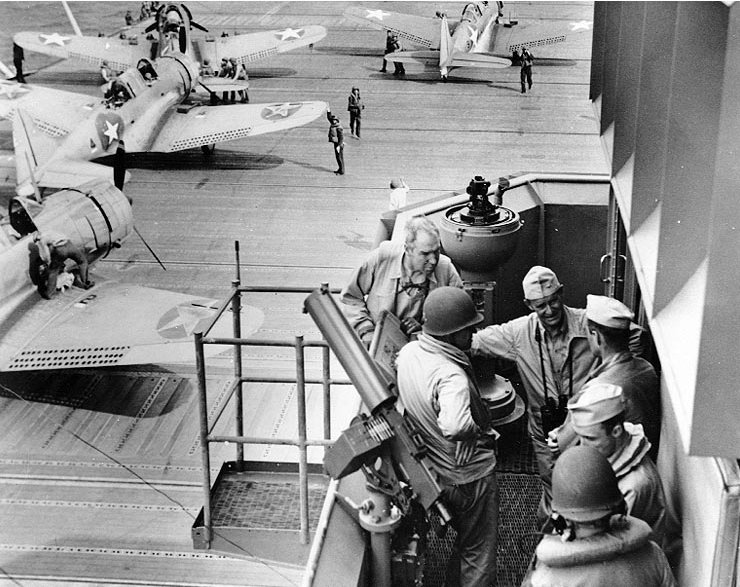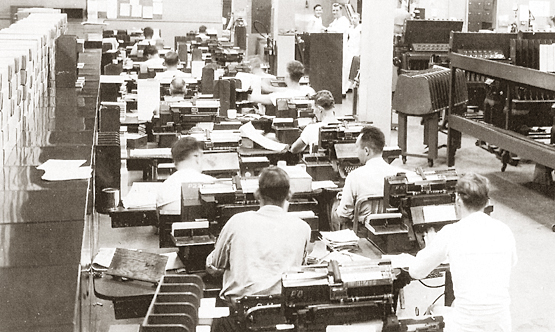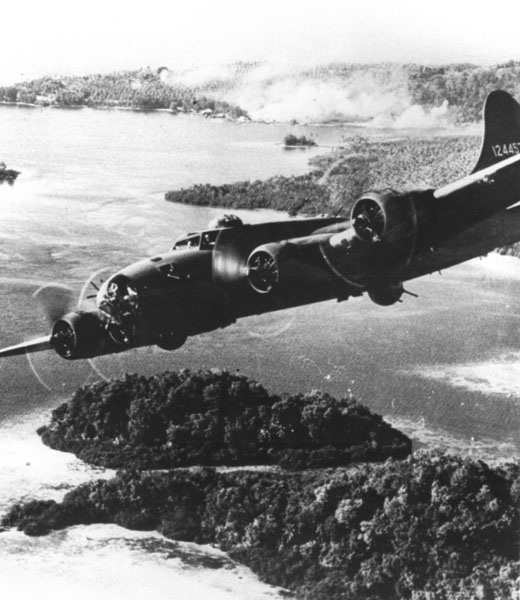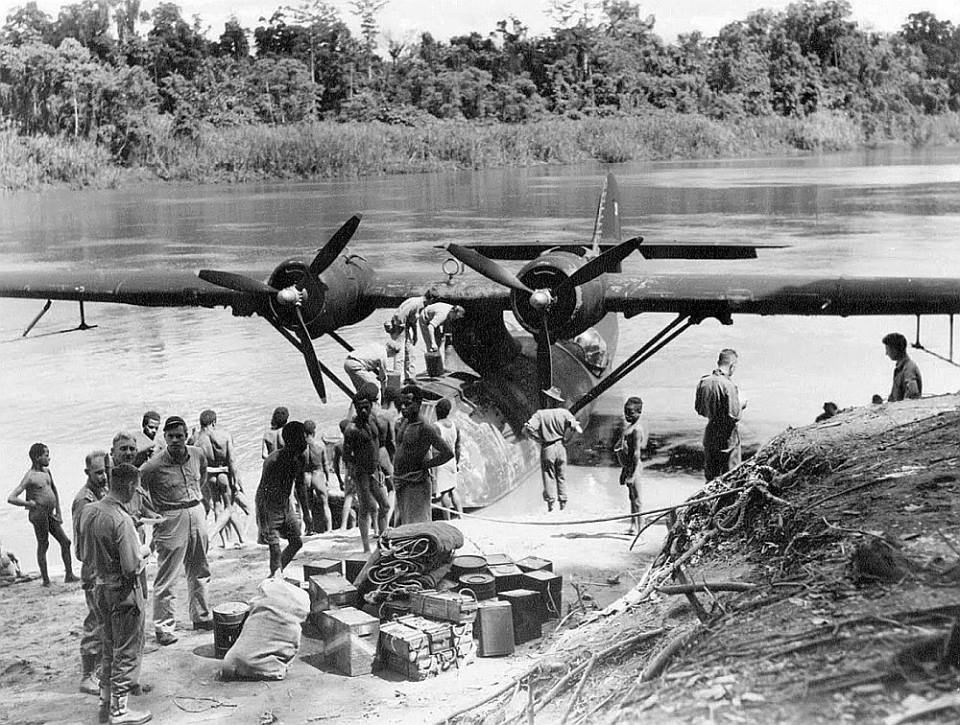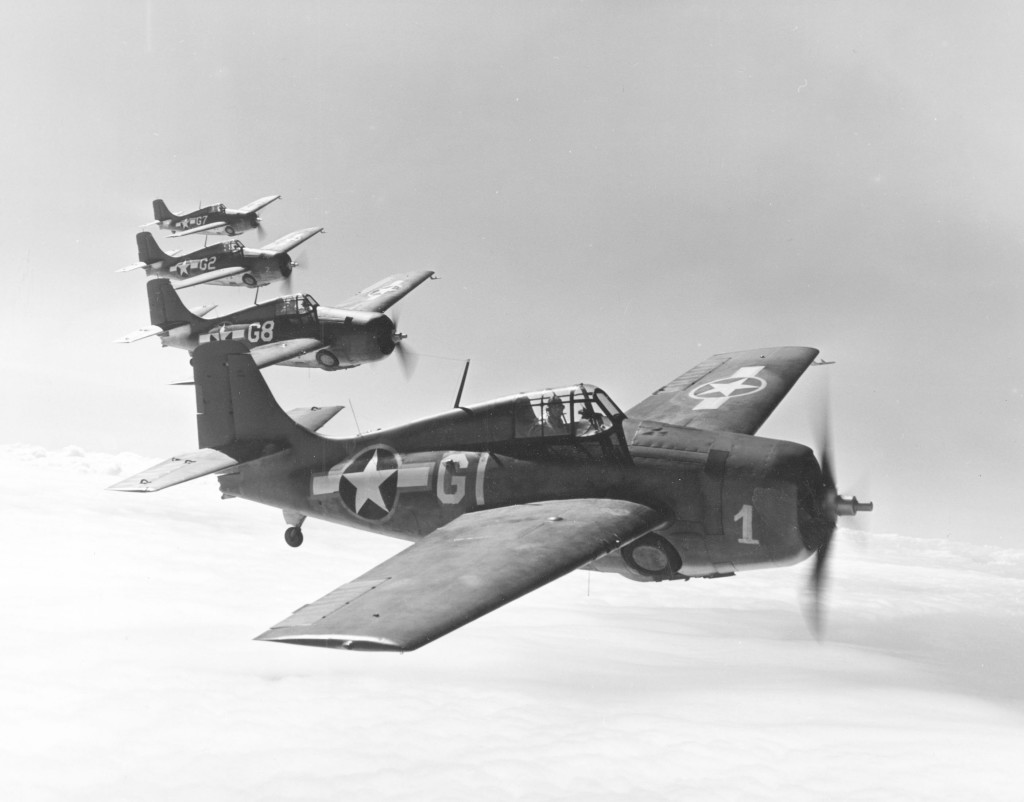Blown Slick Series #13 Part 13 (2/4)
It was one thing to defend Midway operating in open ocean; being closely tied to the geography of the island and surrounding waters to provide air support was a whole other thing. With intelligence far inferior to that during Midway, staying in one general area exposed the carriers to submarine, land and sea based attack. There was much to be learned – at the expense of all participants.
First Day’s Air Support -Problems
Lieutenant Commander Wallace M. Beakley, Commander Wasp Air Group (CWAG), debrief of operations over Tulagi on the bridge wing of the USS Wasp (CV-7), during operations off Guadalcanal on 7 August 1942 after eight hours airborne. Present are (from left to right) Wasp Commanding Officer Captain Forrest P. Sherman, (wearing helmet), Rear Admiral Leigh Noyes, Commander Task Group 61.1 (facing camera), and CWAG Beakley.
The initial operations of 7 and 8 August though mostly successful posed multiple problems. This was most certainly an emerging warfare environment and thus operational learning was critical both in regard to holding Guadalcanal but also in regard to preparation for support of the planned operations of 1943-45 on the pathway to Japan itself. Indeed carrier aviation in 1945 would barely resemble that of ’42.
To understand the evolution of carrier warfare to include expeditionary warfare here are abbreviated summaries of the problems noted at the initiation of the Operation Watchtower campaign.
Communication
The radio links between units and commands were almost always unreliable. The fruits of the wide web of air searches, performed by PBY Catalinas and B-17s operating from bases on New Caledonia, the New Hebrides, Santa Cruz, and Malaita, withered under pressure from bad weather, the shortcomings of human senses, poor coordination, and the vagaries of radio reception. Though the physical reach of the search planes was impressive—PBYs from Malaita could easily reach Rabaul, 650 miles away—aircraft from MacArthur’s Southwest Pacific Command could not communicate directly with South Pacific Area naval units.
Coverage of the Slot on the afternoon of August 8 was a particularly egregious failure. Turner had asked the commander of land-based area air forces, Rear Admiral John S. McCain, to supplement MacArthur’s patrol coverage of the critical waterway. As it happened, McCain’s aviators were blocked by bad weather from flying the missions, but his message to that effect did not reach Turner until nearly midnight on the ninth. Had he known that his eyes in the sky could not fly, he might have alerted Crutchley, Bode, and Riefkohl to the possibility of a naval attack that night. He might also have requested that Fletcher use his carrier planes to fill the gaps in the search net.
Too often, fighter pilots could not communicate with the ships vectoring them, nor sometimes with one another. Bomber pilots couldn’t contact the troops they were flying to support. Search aircraft could not communicate with ships. Squadron commodores could not reach the ship captains under their command. There was no network. In the narrow windows of time in which ignorance was costliest, all too often the components of SOPAC were fatally out of touch.
As his screen was dying off Savo, Turner found he was unable to reach directly the only flag officer on screening duty that night, the capable Norman Scott. The TBS radio in Turner’s flagship, the McCawley, was partially shorted, and was effective only to about eight miles. Getting to Scott required him to go through Riefkohl on Vincennes. Turner couldn’t raise Ghormley, either. According to Ghormley, Turner’s radio frequency “could not be heard by the Commander of South Pacific Force. It is doubtful if all unit commanders of Task Force 61 could hear more than fragments of the blind transmissions on that frequency.” Ghormley could not hear Fletcher, either, and though the McCawley’s communications suite had been bolstered with the addition of sixteen field radios, Turner could not regularly monitor Fletcher’s frequency.
Also in relation to the Battle of Savo Island, by way of significant example, waiting for Ghormley to approve his request to withdraw, Fletcher was still standing by with the carrier task force, some 150 miles from Savo Island and well within striking range of Mikawa. When the approval came and the carriers finally did turn south at 4:30 a.m. on the ninth, Fletcher knew nothing of the opportunity..
Long into the morning as his carriers withdrew, Admiral Fletcher “was completely uninformed regarding the surface actions in Ironbottom Sound during their progress,” according to his subordinate Kinkaid. “Had timely and accurate information of the surface actions been received,” Kinkaid wrote, “it is possible that the carrier air groups could have made the dawn air attack on the Japanese cruiser force which Mikawa so greatly feared.” The carriers hadn’t yet flown. They simply never learned that an enemy was near. Mikawa got away with his kills.
RS note: in extensive reading on the Guadalcanal Campaign, a common thread throughout the whole period is of all commanders assuming their messages are being read and or forwarded by all other commands. Ascertaining that critical information was received in a timely manner or even received at all does not appear to be even a remote priority. While radio technology was certainly a problem, their seemed to be no thought out communications scheme for what was a very complex scenario. By all appearances this was a serious and very costly self inflicted fog of war.
Radar
Installing technology was one thing. Encouraging warriors to discover a second-nature knack for using it was another. The Navy was slow to move beyond the period of high secrecy that surrounded the research. “There wasn’t any real training program,” Rivero said. “That’s one mistake we made. We didn’t think that far ahead.” In 1942, the attitudes of most line officers toward this fledgling technology spanned the full range of know-nothingdom, from raw ignorance to well-considered dismissal. Hanson Baldwin regarded the typical naval officer of the day as “a narrow man, with fixed and unassailable ideas of politics, life, and society; too often—though master of the details—he cannot see the woods because of the trees.”
The problem ran straight to the top. “Our flag officers and senior captains are old compared with those of other navies; far too many of them suffer from nervous or heart disabilities; to stand the great strain of heavy responsibilities they should quite clearly be ten years younger.” As Kelly Turner admitted, “Neither I nor any of my staff knew anything about radar, except by reputation.” By the time the technology reached the fleet, a more capable version, the SG or “Sugar George” microwave surface-search radar, was already making it obsolete and ensuring the continued puzzlement of officers responsible for tactical action.
Intelligence
Unlike at Coral Sea and Midway, Allied radio intelligence now stayed one or two steps behind the Japanese, making the defense of Guadalcanal all that much harder.
After Midway, when the Japanese began changing their high-level operational code groups, U.S. cryptanalysts were left to deduce enemy movements from the patterns of radio traffic, instead of by deciphering their actual content.
This question remained above all others as the days moved on from the initial attack: “Where are the Japanese carriers?”
The odds tilted more in Japanese favor after 15 August, when the IJN finally instituted major revisions in Naval Codebook D. The change just prior to Midway had not frozen out Allied code breakers very long, but this one nearly shut the door at a very significant point of the Pacific War. The change in the Japanese navy cipher sounded the one cautionary note. The code breakers groaned. “Our hopes of reading their important traffic in the near future is remote.”
Station HYPO, at Pearl Harbor known outside the walls as the Combat Intelligence Unit, was the hub of one of three Pacific fleet focused communications intelligence networks focused on breaking Japanese code.
As example, the Cincpac intelligence bulletin Fletcher read on 16 August placed the Hiyo, Juny, and Zuih one thousand miles east of Tokyo but the other carriers were “still in Japan.” The commander in chief of the Second Fleet might be near Saipan, with “slight indications” he was going south. In fact Nagumo’s Kido Butai left southern Japan at the same time that particular Cincpac intelligence bulletin circulated. The Hiyo and Juny actually trained in the Inland Sea, and the Zuih was in port. Only their aircraft staged to eastern Japan. Kond (commander in chief, Second Fleet) already neared Truk. Unlike at Coral Sea and Midway, Allied radio intelligence now stayed one or two steps behind the Japanese, making the defense of Guadalcanal all that much harder.
The fate of Guadalcanal, indeed the outcome of the war-at-sea in the Pacific for both sides became a game of Blind Man’s Bluff !!!
Air Support for Amphibious Operations
As noted Japan would begin by reinforcing Guadalcanal in a manner very difficult for carrier and land-based air alike to stop. Providing close air cover for transporting supplies and men to Cactus would prove most difficult. Fletcher could not simply station his few flattops off Guadalcanal indefinitely to make up for the absence of shore-based air. Pederson observed in 1944, “Carriers cannot be expected to do more than support the assault phase of an amphibious operation,” whereas the “lack of air facilities at Guadalcanal required the carriers to be in position to furnish support.” He recalled Fletcher fully realized the “defensive task of patrolling a given area was dangerous but the role was forced upon us by the urgency of the situation that then existed.” The Allies learned that lesson. In November during the Torch invasion of North Africa, a dedicated land-based air contingent swiftly deployed ashore.
Land based Air
Fletcher strongly advised in his 24 September analysis of carrier operations that bases for land-based aircraft should be established, “Within the shortest possible distance of the objective prior to any invasion effort.” Land planes should stage into the objective as soon as the airfield was ready to take over air defense and release the carriers to withdraw.
Later Admiral Halsey went further.
“However the danger exists that the more important and more fundamental fact may be lost sight of that the land plane bases and the operating units thereon should be available in supporting positions before [Halsey’s emphasis] the operation is undertaken at all. It is only by this provision in advance that the risking of carriers in restricted covering positions can be avoided.”
Thus the question of protecting the carriers off Guadalcanal was much more complex than one might infer from Fletcher’s critics.
The navy’s original plan depended on preinvasion bomber raids against Rabaul and the auxiliary airfield at Buka, but a strong effort was far beyond the capability of MacArthur’s hard-pressed flyers. Now he agreed only to attack Rabaul from D-Day to D+3 and bomb enemy naval forces if detected within 550 miles of Port Moresby. Ghormley warned Nimitz on 29 July, “U.S. forces under MacArthur are not as strong as I expected,” and charged that Washington did not recognize that weakness. Sopac could do nothing about MacArthur’s contribution, vital as it was. McCain’s TF-63 was another matter. His assets, scattered at New Caledonia, Efate, Fiji, and the soon-to-be completed field at Espíritu Santo, comprised three seaplane tenders with thirty PBY flying boats and an equal number of B-17 bombers.
The fast, well-armed B-17s hunted eight hundred miles but required long runways. The lumbering PBYs, flying from sheltered inlets, could go out seven hundred miles. Their principal task was to warn of ships advancing southeast from Rabaul, south from Truk, or southwest out of the Marshalls. Most of McCain’s air bases were distant from Guadalcanal, greatly restricting how far his planes could roam beyond the invasion area. Thus he would leapfrog some of his forces to forward positions.
The Watchtower offensive is accurately described as proceeding on a shoestring. Nothing is truer in that respect than Nimitz’s failure to have land-based planes ready to operate from Guadalcanal. Had the Enterprise brought VMF-223, already equipped for belly tanks or even just its F4Fs for others to fly, and left it at Efate or Espíritu Santo, the carriers would not have worried about remaining off Guadalcanal to protect that part of the invasion force that could not swiftly unload and depart.
The withdrawal of the PBYs from Ndeni compounded the risk of exposing the carriers in advanced positions. McCain’s long-range searches now originated far to the rear, which drastically “shortened the margin of warning [TF-61] could receive of any impending attack.” Long delays persisted in forwarding search results. McCain’s 9 August summary (“all sectors negative”) did not go out until 0114 on the tenth. As soon as Fletcher could circumvent radio silence by flying messages ashore, he requested McCain to send “as soon as possible after completion searches,” the “negative and positive information and percentage of coverage.” In turn Ghormley explained to Leary and MacArthur, “[The]retired position [of ] our carriers while awaiting enemy attack with relation distance Rabaul to enemy objectives makes necessary they receive information [of ] enemy naval surface movements [at the] earliest moment.”
Ghormley’s assessment closely reflected Fletcher’s own thinking. Enemy carriers remained foremost in Fletcher’s mind, as he prepared to wage the big battle he must win to retain control of imperiled Cactus.
Carrier based Operations
Given the tricky mechanics of carrier operations, the flattops simply could not launch or recover aircraft on demand, as Nagumo learned to his vast dismay at Midway. Bombers flying ground support missions could tie up flight decks and delay the launch of combat air patrol reinforcements. Multiple CAPs were required – over the targets, protecting the transports, and of course the CV’s themselves. These screen combat air patrols often needed thirty minutes to reach station, and dwindling fuel often forced it to leave early. Even with reliable warning, it was still a considerable trick to launch and vector fighter planes from aircraft carriers to intercept at the right place and time.
The badly flawed placement of fighters also severely compromised the air defense on 7–8 August. Analysis showed that inferior altitude, dispersal of assets, intermittent communications, and remarkably effective fighter opposition devastated the screen combat air patrol on 7 August. The commanding officer of VF-5 likened the piecemeal commitment of his F4Fs to scraps tossed into a “Japanese meatgrinder.” Inadequate numbers of fighters over the Amphibious Force on 8 August, despite the early warning, stemmed primarily from the Saratoga’s inability to launch F4Fs on demand.
“In a large complement of mixed types such as was embarked in the Saratoga, flexibility in the use of fighters is seriously compromised.”
Japan was reinforcing and attacking Guadalcanal in a manner very difficult for carrier and land-based air alike to stop. Providing close air cover for transporting supplies and men to Cactus would prove most difficult. Fletcher could not simply station his few flattops off Guadalcanal indefinitely to make up for the absence of shore-based air.
Pederson observed in 1944, “Carriers cannot be expected to do more than support the assault phase of an amphibious operation,” whereas the “lack of air facilities at Guadalcanal required the carriers to be in position to furnish support.” He recalled Fletcher fully realized the “defensive task of patrolling a given area was dangerous but the role was forced upon us by the urgency of the situation that then existed.” The Allies in the European theater had learned that lesson. In November during the Torch invasion of North Africa, a dedicated land-based air contingent swiftly deployed ashore.
The failure to coordinate carrier and land-based air constituted one of the gravest Allied weaknesses in the Solomons campaign.
In Conclusion -Evolution of the type of Fight
The pattern of fighting through June 1942 had suggested that carriers would play the deciding role in the naval war against Japan. What kind of fight this South Seas campaign would become remained an open question. Carriers would be important, but after the Battle of Savo Island it was clear that the “gun club” didn’t need disbanding yet. Admiral Ghormley knew in his bones the power of the battleships.
The fight that was taking shape in the southern Solomons was going to be neither a single, climactic World War I–style daylight slugfest nor a repeat of Midway, a dance of search planes and long-range naval air strikes. The South Pacific Forces would draw strength from a foundation of supply and reinforcement built far south of the point of contact with the enemy. And the point of the spear that dueled with the enemy would be the surface fleet—destroyers, cruisers, and battleships, aided by aircraft, whose job would be to seize control of the seaways from the enemy.
Neither the Navy nor the Marines had fought a war like this before. Its finer points would be developed, tested, and adjusted on the fly over time.
Next, Admiral Fletcher’s crucial and controversial decision on his carriers.

